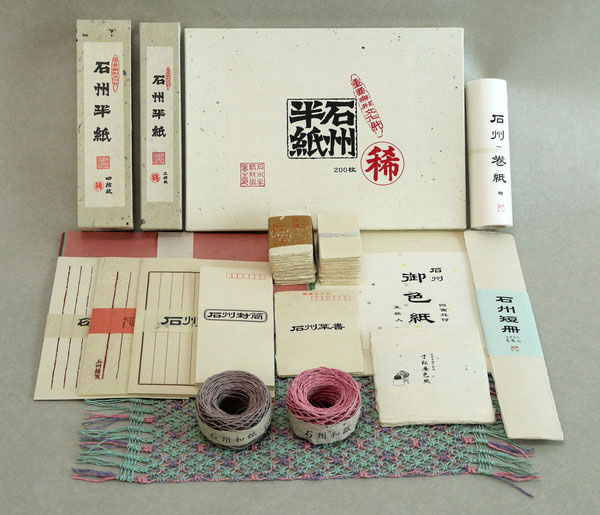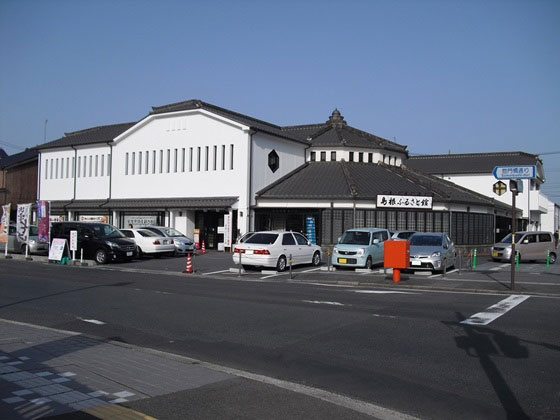 Photo:Shimane Perfecture
Photo:Shimane Perfecture
- Traditional Japanese paper
- Shimane
Sekishu traditional Japanese paper Sekishu washi
Delicate Japanese paper that combines toughness and flexibility
Its whiteness acquires an exquisite light yellow tint over the years
Description
What is Sekishu traditional Japanese paper ?
Sekishu washi is a traditional Japanese paper produced in the Iwami region of Shimane prefecture. As an ancient craft, it has a history of around 1300 years. The name Sekishu is found in writings from the Heian period (794-1185). There is also a statement from the Edo period (1603-1868), about how during the Nara period (710-794), Kakinomoto no Hitomaro (notable poet and aristocrat) “taught the populace to make Japanese paper”.
Sekishu washi makes good use of the fibers of the mitsumata plant, as they are on average, about 10 mm long and mesh together easily. The completed paper retains its strength even when folded or rubbed, and is even stronger than wood pulp paper.
Although slightly inferior in toughness, the paper is smooth and flexible. Its soft sheen makes it suitable for use in printing and for calligraphy. Sekishu gampi paper is made from gampi fibers which are about 3 mm in length and incredibly delicate, but resistant to insect damage, as well as tolerant of humidity. Gampi paper is glossy, translucent, and used in a large variety of products, including paper for calligraphy, certificates of merit, paper for dyeing, and stationery.
Industrial paper machines are mechanized versions of the technology and techniques used for washi paper. Examples of washi paper technology are nagashizuki and tamezuki manual paper making machines. They have screens which must be made of either bamboo or Japanese nutmeg tree. Also aibika must be used to bind the paper fibers together. Then the fibers are dried on a drying board made of either wood or iron. All of these requirements lead to recognition for the craft as Sekishu washi.
History
From the beginning of the 8th century, for about 1300 years, Sekishu washi was made in the Iwami district of western Shimane prefecture. In the Edo period, Osaka merchants used Sekishu washi for their account books. This was the type of washi that was most important for their businesses, keeping records of the customers. It is said that even if there was a fire, they would throw the ledger with the customer names into a well to save it from being burned because when it was taken out, the paper was untorn and had not dissolved, so they could start doing business again.
In 1969, the Sekishu calligraphy paper produced by the Sekishu Calligraphy Paper Craftsmen Association was designated a National Important Intangible Cultural Asset. In 2009, in accordance with a UNESCO treaty, Sekishu-banshi, calligraphy paper, was recorded as an Intangible Heritage of Humanity. Even today, Sekishu washi is used as a special type of washi for the restoration of cultural properties. Still today this handicraft is being carried on by young artisans.
General Production Process
- 1. Steaming the raw materials
The plant materials used for Sekishu washi are locally grown kozo, mitsumata, and wild gampi. The wood is cut at a diagonal angle and in approximately meter long segments by a sickle. Once the wood has been aligned and cut, it is steamed in a bamboo steamer, which makes the peeling of the core material and outside skin easier to do. The branch is held in one hand and the bark in the other, and then both are wedged between the feet so that the bark can be stripped from the branches in such a way that the stripped barks make a cylindrical shape. The black bark is tied in bundles and dried naturally with outside air. After it has been dried partially, it is stored.
- 2. Shaving black bark
After the black bark has been soaked in water for about half a day and softened, the skin is carefully shaved on a sozoridai or shaving board with a knife. The part between the outer skin and white inner layer is left intact in order to bring out the toughness of the kozo.
- 3. Boiling
The white inner layer of the bark is stripped off in spring water and carefully shaken to wash away impurities. A mixture of water and soda ash, with the soda ash amounting to 12% of the total water, is heated to boiling in a large vat. The raw material is loosened as it is being added. For about two hours it is boiled and steamed while turning it over approximately every thirty minutes so as to prevent uneven places from developing. When the boiling is finished, the next stage is to wash the material carefully in spring water to remove dust and other impurities. For kozo, during the process of removing harshness, dust is removed from each individual strip.
- 4. Beating
The raw material is placed on a hard wooden board and its fibers are crushed by beating it with rods made of oak. For Sekishu washi, the beating goes from side to side, left to right and back again, six times, while the material is reversed, top and bottom, six times.
- 5. Stirring materials
A viscous liquid consisting of water, paper raw material, and aibika (which works to bind the fibers together) is put into a vat and stirred with a stick to break it up and make it uniform. Making Sekishu washi is done in three basic stages: kazushi, choshi, and sutemizu. The rapid lifting out of the paper material from the vat and the use of an entire screen of split bamboo to form the surface of the paper is called kazushi.
- 6. Shaking materials
Choshi involves scooping out a deep layer of the paper material and shaking it from front to back to make the fibers intertwine, thus creating a layer of Japanese paper.
- 7. Throwing out material
The thickness of the paper is determined by the number of times that choshi is performed. Sutemizu is when the paper reaches the right thickness, any superfluous water or paper material is vigorously shaken and thrown out.
- 8. Transferring paper beds
After straining, the water on top of the paper on the paper bed is drained well. The paper is stacked sheet by sheet, moved, and then left overnight. The pressure of a compressor is gradually increased to squeeze the water out of the paper bed.
- 9. Drying
The peeled off sheets of paper are compressed, squeezed, and then brushed onto drying boards made of gingko wood. The drying boards with the wet paper stuck to them are dried in the sun. This step results in beautiful resilient and pliant Sekishu traditional paper.
- 10. Sorting
After drying, the washi is sorted and any sheets with unevenness, thickness, or dust, are gently removed. Sheets of washi that have made it through this selection process are cut to suit their intended uses, and that is the finished product.
Where to Buy & More Information
Shimane Bussan Kankokan
 Photo:Shimane Perfecture
Photo:Shimane Perfecture
-
Address
-
Tel.+81-852-22-5758
-
ClosedAround the New Year
-
Business Hours9am to 6pm
-
Website
See more Traditional Japanese paper
- Mino traditional Japanese paper
- Echizen traditional Japanese paper
- Tosa traditional Japanese paper
- Sekishu traditional Japanese paper
- Inshu traditional Japanese paper
- Awa traditional Japanese paper
- Ozu traditional Japanese paper
- Echu traditional Japanese paper
- Uchiyama Japanese paper































































































































































































































































































